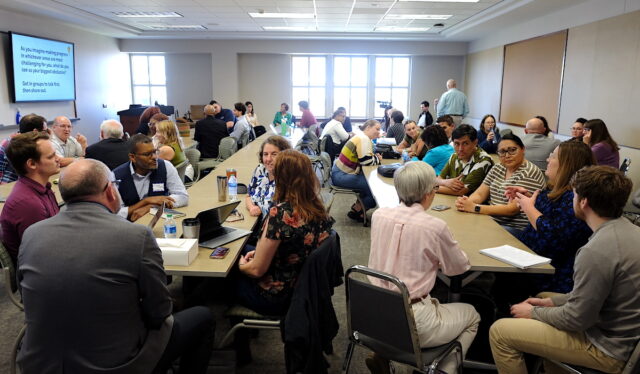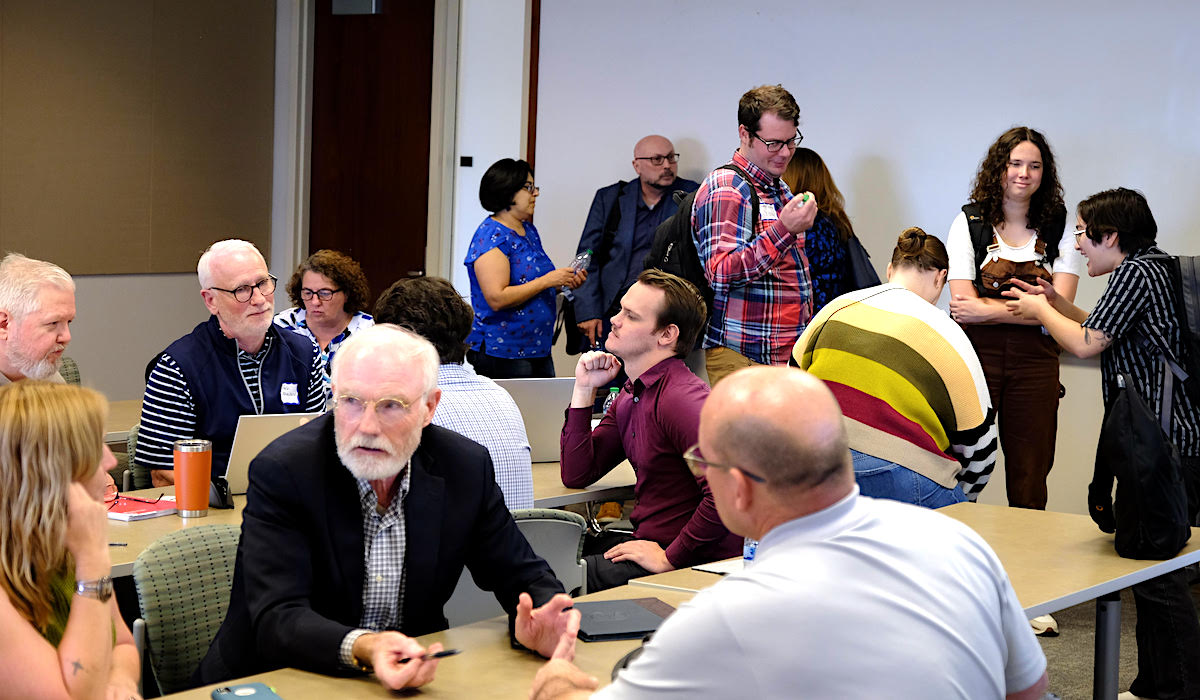

The nonprofit news sector is rapidly expanding in Oklahoma, providing more evidence of a remarkable shift in the landscape of American journalism.
Two recent developments illustrate this trend:
- Oklahoma Voice, a nonprofit news outlet funded by out-of-state donors, made its debut in late August. The State Capitol-focused news stories produced by its four-person reporting team have been quickly picked up by traditional newspapers whose reporting staffs have shrunk;
- KOSU announced recently it received a $250,000 grant that will enable it to hire a full-time reporter to cover the State Capitol. The content will be shared by the four National Public Radio affiliates in Oklahoma and made available to state newspapers and other news outlets.
In both cases, philanthropic foundations and individual contributors are now paying the salaries of a growing cadre of Statehouse reporters who work side by side with those employed by traditional, for-profit newspapers and broadcasters.
These changes not only help to ensure that the actions of state officials will continue to receive sufficient scrutiny, but they also signal a new era of cooperation between nonprofit and for-profit news teams.
Tectonic shift in American journalism
For the record, I am not a disinterested observer. I worked at Oklahoma Watch for several years and currently serve as chairman of NonDoc Media’s governing board. The observations in this column are my own, and they do not necessarily reflect the thinking of NonDoc’s editorial staff.
As a retired journalist who covered the Oklahoma Capitol in the late 1970s and early 1980s, I recall fondly the days of dog-eat-dog journalistic competition. Yet I am convinced that the new era of more collaborative coverage is serving the greater good of our state and nation.
The growth of nonprofits reflects tectonic shifts in American journalism. Traditional newspapers in particular have been hard hit by the rise of social media as primary news sources, the reluctance of news consumers to pay for subscriptions, and the flight of advertisers to other platforms.
As newspapers’ revenue streams have declined, so has their ability to cover the actions of state and local governments. Across the country, scores of new nonprofit organizations have sprung up to help fill the void.
A study by the Pew Research Center found that reporters working for nonprofits constituted 20 percent of all Capitol journalists in 2022, up from 6 percent in 2014. Nonprofit reporters made up the largest portion of the Statehouse press corps in 10 states and the second-largest in 17 states.
Interested in learning more about this shift, I contacted a few veteran journalists to hear their perspectives.
University of Oklahoma journalism professor John Schmeltzer said the expanding role of nonprofits reflects the financial freefall of traditional media. Schmeltzer oversees OU’s Gaylord News program, which deploys student reporters in Oklahoma and Washington, D.C.
“The issue for the for-profit media outlets is the lack of a new revenue model, because subscription revenue doesn’t appear to be working as a replacement for advertising,” Schmeltzer said. “That’s where nonprofits — such as Oklahoma Voice, NonDoc, Oklahoma Watch, The Frontier and even Gaylord News — come in. They can fill the gap with professional-level content as for-profit newsrooms continue to shrink.”
Oklahoma Voice, which began posting stories on Aug. 29, is staffed by four journalists recruited from for-profit newspapers. It joins a roster of existing nonprofits such as Oklahoma Watch, The Frontier, NonDoc Media and StateImpact Oklahoma.
Oklahoma Voice differs somewhat from other nonprofits in two respects. First, its reporters are mainly posting quick-turnaround news and feature stories, instead of writing the kind of deeper-dive investigative stories that Oklahoma Watch and The Frontier tend to produce. Second, it is funded by a national nonprofit called States Newsroom, which has launched similar operations in 35 other state capitols.
“Our focus is on content that has broad statewide interest,” said Oklahoma Voice editor Janelle Stecklein. “We’re interested in taking a look at how state policies are working, at the people involved in making those policies, and the people who are impacted by those policies.
“We’re here to supplement the existing ecosystem, not replace it.”
Before joining Oklahoma Voice, Stecklein covered the Oklahoma Capitol for the CNHI newspaper chain. Her three-person reporting staff consists of Carmen Forman, a former Statehouse reporter for The Oklahoman and Tulsa World; Nuria Martinez-Keel, who covered education for The Oklahoman; and Mindy Ragan Wood, a former Norman Transcript government reporter.
Nonprofit news outlets seen more as potential partners

In the first four weeks following its Aug. 29 launch, Oklahoma Voice’s reporting team posted 60 stories. The stories addressed topics such as Gov. Kevin Stitt’s ongoing feud with Native American leaders, the flight of employees from the Oklahoma Department of Education and efforts to revive the annual prison rodeo in McAlester.
The Oklahoman republished 25 of Oklahoma Voice’s initial 60 stories. It placed three of them on its front page. Oklahoma Voice stories also were picked up by CNHI papers such as the Norman Transcript, Duncan Banner and Muskogee Phoenix.
“We welcome Oklahoma Voice,” said Ray Rivera, executive editor of The Oklahoman. “Every state capitol needs more reporters watching over government officials and doing accountability reporting. We feel by running their stories, we’re helping them gain circulation and visibility, and they help us by doing stories that we might not be able to get to. (…) I think it’s a great symbiotic relationship.”
The ready acceptance of Oklahoma Voice by legacy newspapers illustrates the extent to which nonprofit news outlets have become an integral part of the journalism infrastructure.
A generation ago, most newsroom managers would have regarded nonprofit startups as competitors. Today, they are increasingly viewed as potential partners.
It’s the kind of collaborative atmosphere being encouraged by the Oklahoma Media Center, a different nonprofit entity whose mission is “to support and strengthen Oklahoma’s local journalism ecosystem and spur innovation through statewide collaboration that benefits diverse audiences.”
Although the Oklahoma Media Center does not produce content, it fosters partnerships and provides funding, training and collaborative support for participating newsrooms.
“I think it is imperative that we collaborate,” said KOSU executive director Rachel Hubbard, who will administer the two-year $250,000 grant from the Corporation for Public Broadcasting to finance the hiring of a Statehouse reporter. “I feel like the call for us is not to cannibalize each other, but to act as an ecosystem.”
Before choosing Oklahoma’s NPR affiliates as grant recipients, CPB conducted a study that identified Oklahoma as a state particularly at risk of having insufficient coverage of state government, Hubbard said.
Increasing competition for experienced journalists
Oklahoma Watch executive editor Ted Streuli said he, too, is pleased that the ranks of nonprofit reporters are expanding.
“More journalism organizations are better for the public than fewer journalism organizations,” Streuli said. “You get more viewpoints, you get more stories, you get more reporters looking at things.”
Donate to nonprofit news:
• NonDoc Media
• Oklahoma Watch
• The Frontier
• StateImpact
• Oklahoma Voice
Streuli said he was somewhat more concerned about the proliferation of nonprofit news organizations — not just in Oklahoma, but nationally — that are seeking support from a limited roster of charitable foundations and individual donors who will support news operations.
That may be changing. In early September, a coalition of 22 big philanthropic donors — including the Ford Foundation, the Knight Foundation and the MacArthur Foundation — announced a nationwide initiative to support local journalism. Called Press Forward, it plans to dispense more than $500 million over five years to for-profit and nonprofit journalism outlets alike.
“The number of philanthropic organizations willing to fund journalism is growing,” Streuli acknowledged. “But I’m not sure it’s growing as fast as nonprofit journalism.”
Managers of other news organizations expressed concern about increasing competition for experienced reporters and editors. The Oklahoman and Tulsa World have posted openings for the positions vacated by Martinez-Keel and Forman. But it was not yet clear whether CNHI, which owns the Norman Transcript and a dozen other Oklahoma newspapers, plans to replace Stecklein and Wood.
Competition for revenue sources and good staffers has been a constant throughout the history of American journalism, though. I believe it is fundamentally healthy, even if it causes anxiety among some newsroom executives.
The ultimate measure of Oklahoma’s reconfigured press corps should be whether it provides the state’s readers, listeners and viewers with a more robust mix of Oklahoma-focused news content.
In that context, the arrival of more nonprofits and the increased emphasis on collaboration versus competition are encouraging developments.
(Correction: This article was updated at 2 p.m. Friday, Sept. 29, to correct reference to newspapers owned by CNHI.)




















